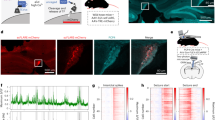Abstract
AFTER lesions have been made in one side of the nigro-striatal system, rats have been found to rotate when administered drugs which release dopamine (such as amphetamines) or activate dopamine receptors (such as apomorphine) in the corpus striatum (see for example refs 1 and 2). Because this circling effect is specific to the nigro-striatal system3 and because it has been established that rats consistently rotate contralateral to the more active striatum (for example ref. 4), the lesion–rotation paradigm is now commonly used as a model for the study of nigro-striatal function. Studies5,6 in our laboratory have shown that rats without lesions also rotate when administered doses of the same drugs larger than those administered to lesioned rats. As in lesioned rats, the directoin of rotation is consistent for normal rats; when tested on several different occasions with the same dose of the same drug, some rats consistently rotate to the right and others rotate to the left. This suggested that normal rats have an intrinsic asymmetry between left and right sides of the nigro-striatal system which is accentuated by drugs. This functional asymmetry corresponds to a chemical asymmetry7: the dopamine contents of normal left and right striata were found to differ by 10–15%. After administration of (+)-amphetamine, the dopamine contents of left and right striata were found to differ by 25%. Moreover, in response to (+)-amphetamine, rats consistently rotated contralateral to the side containing the most dopamine. This normal asymmetry suggests an inter-hemispheric mechanism that maintains or regulates the asymmetry. Mensah and Deadwyler8 demonstrated in rats a pathway between left and right caudate nuclei coursing through the ventral corpus callosum. It seemed plausible that this pathway may be part of the mechanism maintaining striatal asymmetry. We have now found that the striatal asymmetry is potentiated, both functionally and chemically, by callosal section.
This is a preview of subscription content, access via your institution
Access options
Subscribe to this journal
Receive 51 print issues and online access
$199.00 per year
only $3.90 per issue
Buy this article
- Purchase on Springer Link
- Instant access to full article PDF
Prices may be subject to local taxes which are calculated during checkout
Similar content being viewed by others
References
Ungerstedt, U., Acta physiol. scand., Suppl. 367, 49 (1971).
Ungerstedt, U., Acta physiol. scand., Suppl. 367, 69 (1971).
Crow, T. J., Expl Neurol., 32, 247 (1971).
Arbuthnott, G. W., and Crow, T. J., Expl Neurol., 30, 484 (1971).
Jerussi, T. P., and Glick, S. D., Neuropharmacology, 13, 283 (1974).
Jerussi, T. P., and Glick, S. D., Psychopharmacologia, 40, 329 (1975).
Glick, S. D., Jerussi, T. Pl., Waters, D. H., and Green, J. P., Biochem. Pharmac., 23, 3223 (1974).
Mensah, P., and Deadwyler, S., J. Anat., 117, 281 (1974).
Glick, S. D., and Greenstein, S., Br. J. Pharmac., 49, 316 (1973).
Ungerstedt, U., and Arbuthnott, G. W., Brain Res., 24, 485 (1970).
Teitelbaum, H., J. comp. Physiol. Psychol., 76, 51 (1971).
Szilagyi, P. I. A., Green, J. P., Brown, O. M., and Margolis, S., J. Neurochem., 19, 2555 (1972).
Laverty, R., and Taylor, K. M., Analyt. Biochem., 22, 269 (1968).
Zimmerberg, B., Glick, S. D., and Jerussi, T. P., Science, 185, 623 (1974).
Hornykiewicz, O., in Recent Advances in Parkinson's Disease (edit. by McDowell, H., and Markham, C. H.), 33 (Davis, Philadelphia, 1971).
Glick, S. D., and Jerussi, T. P., J. Pharmac. exp. Ther., 188, 714 (1974).
Author information
Authors and Affiliations
Rights and permissions
About this article
Cite this article
GLICK, S., CRANE, A., JERUSSI, T. et al. Functional and neurochemical correlates of potentiation of striatal asymmetry by callosal section. Nature 254, 616–617 (1975). https://doi.org/10.1038/254616a0
Received:
Published:
Issue Date:
DOI: https://doi.org/10.1038/254616a0
This article is cited by
Comments
By submitting a comment you agree to abide by our Terms and Community Guidelines. If you find something abusive or that does not comply with our terms or guidelines please flag it as inappropriate.



